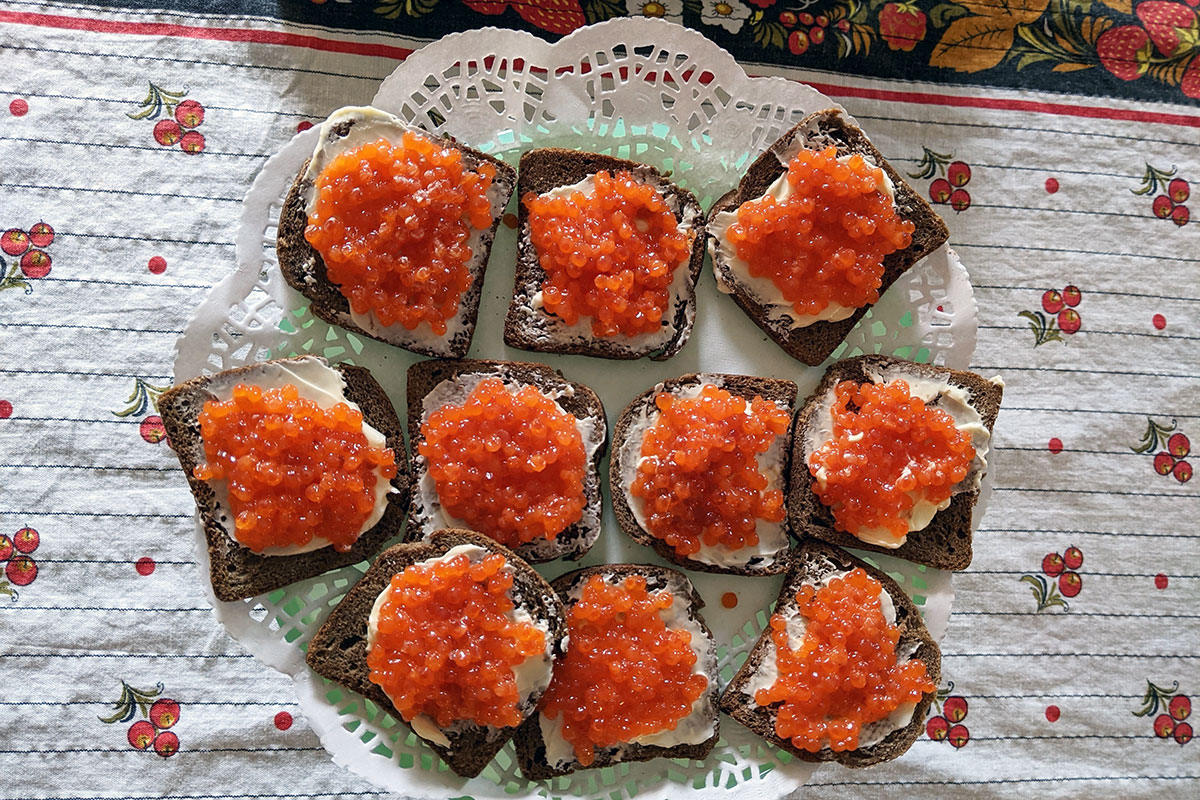The New Year’s Eve revelries of my mother’s Soviet childhood were notoriously grand affairs. New Year’s Eve in my post-Soviet, Midwestern household is decidedly not.
The television blasts with the frenzy of the impending ball drop and the chatter of freezing-cold couples in Times Square who are probably reevaluating this “fun idea.” Our Christmas tree, which stays up until well past January 7 (we’re not religious, but we do symbolically observe Orthodox Christmas), provides plenty of ambiance with its as-seen-on-TV lights.
Yet perhaps the loudest object in the room stands on our mid-sized dining table laden with pickles, cheese, pre-frozen appetizers, and, inevitably, a green plastic platter bearing fresh bread piled with tiny, shiny, violently orange spheres nestled in creamy yellow butter.
My relationship with caviar, particularly salmon roe (in Russian, икра, pronounced ikra), has ebbed and flowed over the years. In my childhood, I wouldn’t touch it. In my high school days, I suddenly found myself piling it high on sour cream-slathered blini. But now, as an adult, I can only stomach a spoon or two of the overwhelmingly salty pearls. And no amount of bread or butter has been able to rectify that.
What hasn’t fluctuated at all, however, is the pre-New Year’s menu-setting conversation.
“Should we have caviar?” is my mother’s near-annual question.
While my mind screams “No!” my response is an inevitable, if not slightly hesitant, “Sure.” I tell myself on the cusp of every January 1 that this’ll be the year when I’ll finally like the taste of caviar, yet yearly I am met with the same disappointment of just not enjoying the delicacy. There’s also the twinge of guilt at making my mom polish off whatever’s left on the platter in the first few days of the new year (although I have yet to hear her complain about this thankless job). But at this point, our New Year’s table is just incomplete without it.
For the handful of Eastern European grocery stores scattered about the tri-state area, it’s a relatively uncommon diaspora to find yourself a part of in my little corner of Southwest Ohio. As I’m only half Russian, my Midwestern upbringing consisted of a standard Christmas celebration on December 25 (and I would usually get a few extra presents on January 7, because my mother, like many others, is just like that). I revered Santa Claus instead of Ded Moroz, or “Grandfather Frost,” the Soviet iteration of the jolly man who instead makes his rounds on New Year’s Eve.
There’s been everything from kulebyaka (Russian fish pie) and the ubiquitous mayo-laden “salads” of my mother’s childhood to Skyline chili dip and black raspberry chocolate chip ice cream (Cincinnati staples) among the many holiday dinner tables I’ve encountered. These spreads have embodied the magnificent mishmash of regional identities I enjoy, and that’s why I’m always sure there’s a place at our table for caviar come December 31, regardless of the other dishes it accompanies.
Caviar is often associated with a sort of decadence in the minds of many. I would be lying if I said we hadn’t dished up the violently vivid foodstuff in a shameless bid to awe dinner guests in the past (it’s worked,) but salmon roe, specifically, isn’t very hard to find or afford. Squint hard enough through the frost-laden window of a freezer in an Eastern European grocery store, and you’ll probably be able to make out a stout, pine green can of it. Sturgeon caviar, which resembles small, greenish-black beads, is a type that will cost you, and I myself have yet to try it (just a knock-off variety made with seaweed and other fish).
If you’re partial to popping boba in your milk tea, the texture of roe will not shock you. The burst of fishy brininess, however—and take this from someone who loves any and all seafood—is not for the faint of heart, even with a healthy layer of butter along for the ride.
On the recent drive home from the airport, having just arrived for the holidays from my semester in Delaware, my mother explained that the whole idea behind those little caviar sandwiches is contrast: the sweet butter versus the salty fish eggs—two disparate flavors that may not usually be paired but, when combined, somehow manage to work. My life has been one of subtle yet fascinating contrasts, and my dinner table has not been spared.
I may not like the flavor. But I can’t deny it: for me, caviar is the taste of New Year’s.
Recipe: Caviar Sandwiches
Putting this dish together is so straightforward that I hesitate to call it a “recipe.” The only real labor will likely take the form of finding roe. I’d wager you can find it in most Eastern European grocery stores or international food markets.
Hopefully this simple-to-compile recipe will bring something new to your table for years!
Ingredients
Bread – My mother and I usually opt for a mix of pre-sliced white bread and rye. The smaller the slices, the better. You can also use crackers or blini, if you’re feeling particularly fancy!
Butter – My mother strongly recommends unsalted. The creamier, the better.
Caviar
Preparation
Spread the slices of bread with butter. Spoon an even layer of caviar on top.
Pop open the champagne (taking special care to point the bottle away from family and family heirlooms).
That is all. Happy New Year! Or, as we say, С Новым годом!
Nadya Ellerhorst is an intern at the Center for Folklife and Cultural Heritage and senior at the University of Delaware. There will likely be caviar among her 2023 New Year’s Eve spread. Whether or not she will actually eat it is a question best left for 2024.


